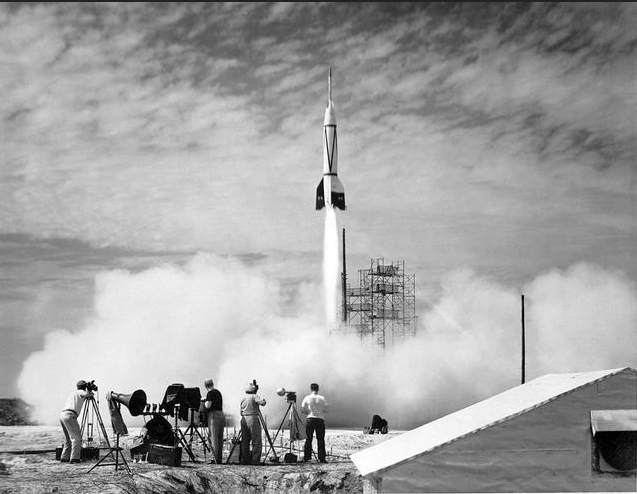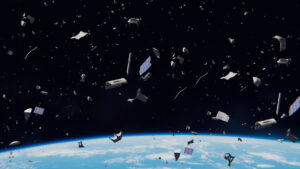First Man-Made Object in Space: Myths & Facts Explained
20th Sep 2022
What was the first man-made object in space? Most people know that the Soviet Union’s Sputnik, launched into Low Earth Orbit (LEO) on 4 October 1957, was the first man-made satellite in space. But was it truly the first man-made object in space? You’d be surprised, but probably not. Read on to find out what was truly the first one and which ones are only rumoured to have reached space.
Is a manhole cover the first man-made object to reach space?
Not to bury the lead — no, the manhole cover in space is most likely a myth. But why would people even believe such a thing? Well, in 1957, the United States was actively engaged in nuclear tests. A total of 29 tests were carried out between May and October 1957, and one of them, Pascal-B, conducted on 27 August, gained a little more notoriety than expected. An underground nuclear explosion blasted a half-ton concrete manhole cap upwards. The cover itself was never retrieved, and some scientists believe that this cap remains one of the fastest-moving objects ever ‘accelerated’ by people. So, did the manhole cover go into space?
According to Dr. Brownlee’s interview with Business Insider, the Pascal-B moving manhole could have reached 37 miles/second (130,000 mph), which is five times more than the velocity necessary to escape our planet’s gravity. Still, despite such impressive speed, there is no direct evidence that this man-made object ever reached space.
Was the V-2 the first man-made object in space?
The answer to this depends on how we define the border of space. Different agencies offer different altitude estimates, but generally, the Karman Line, located at 100 km altitude, is now the internationally recognized border of space. On 20 June 1944, the German V-2 rocket MW 18014 launched from the Baltic coast, and crossed the Karman Line before reaching apogee at 176km. Our lowest orbit, LEO, starts at roughly 250 km above Earth’s surface, so V-2 spaceflight was suborbital. Regardless, it did cross the Karman Line, so the German V-2 rocket was the first man-made object in space.
V-2, Germany & Nazi space programme
Given such impressive results, why didn’t Germany become the first nation in space? Primarily, the V-2 was seen as an extension of artillery. Two years after V-2 became the first thing in space, over 3000 V2 rockets had been launched into Allied targets instead, so the war seriously impinged upon Germany’s unquestionable space potential of the time. Once WWII ended in Europe, all of its ballistic designs capable of suborbital spaceflight found their way to the US, UK and USSR science institutions. However, the German V2 rocket concept, developed since the 1930s, served as a basis for upcoming US and Soviet rockets after 1945 and all space-faring objects that followed.
The first man-made object on the Moon
Obtaining Germany’s space developments soon led to the Space Race between the USSR and US, and during the first few years, the Soviets outperformed the Americans. The first man-made object on the Moon was Soviet Luna-2, which touched the lunar surface on 13 September 1957. This was unmanned spacecraft that transmitted first signals from Moon back to Earth. Spacecraft carried a scientific payload that measured electromagnetic and ionizing radiation on its way to the Moon.
The first US man-made object in space to orbit Earth
The US sent its first satellite, Explorer-1, into orbit on 31 January 1958 — just a few months after USSR’s Sputnik, and it became the first American object in space to orbit Earth. The US satellite was launched on a Jupiter C rocket, developed under the supervision of Dr. Wernher von Braun, the chief scientist behind the German V-2 programme. Explorer-1 could complete 12.54 orbits a day, or one orbit every 114.8 minutes. The satellite transmitted its last signal in late May 1958, and twelve years later, on 31 March 1970, it entered our planet’s atmosphere and burned up on descent.
What about Great Britain?
The first British satellite programme was started in 1959. In 1962, four years after Explorer-1, Great Britain launched its own first artificial satellite Ariel-1 using the famous Black Arrow rocket.
First object in interstellar space, created by humans
In 1977, the US launched its Voyager-2 probe, the first man-made object that got to deep space. In fact, this probe only reached interstellar space in August 2012. Voyager became the first thing created by people to reach Jupiter in 1980 and is still one of the most important things humanity has sent to space from the point of view of the information it transmitted back to Earth. Voyager-1 sent us the first photograph from space and gave us detailed shots of other planets in our solar system. Its last transmission about space matter density happened in 2021, 44 years after its first launch! As of today, Voyager is the most remote and man-made object in interstellar space.
Aren’t we creating space junk?
Sadly, launching satellites, rockets, and probes into space has a downside, too. Not all things created by humans that served their purpose, enter our planet’s atmosphere to burn down on descent, like Explorer-1. Many defunct satellites remain in orbit, drifting there as useless space debris. Also, there are smaller pieces of debris, including spent rocket and satellite component parts. As of today, NASA reports 27,000 pieces of space junk that pose a danger of collisions to currently operating spacecraft and the ISS. ESA says that the number of space debris created by satellite launches exceeded 30,000.
Fortunately, space agencies and private aerospace companies are working on ways to clean up our planet’s orbits — particularly the most clustered LEO. After all, if aerospace giants do not come up with a solution, LEO and further paths to the stars may become impassable — and that goes against their plans of building bases on the Moon and eventually colonizing Mars.






Thank you for your comment! It will be visible on the site after moderation.